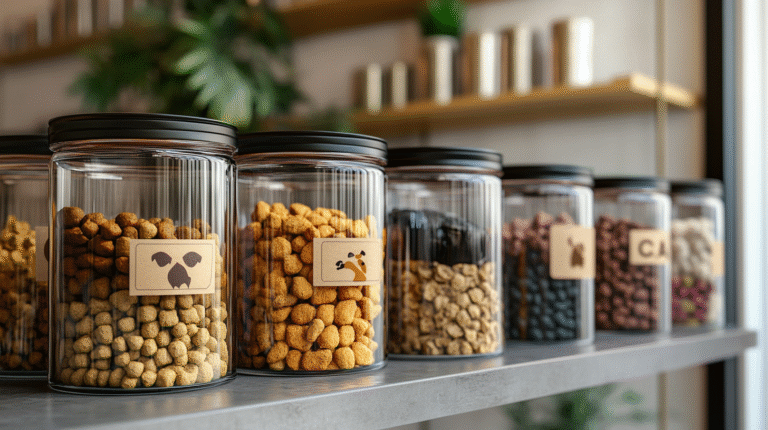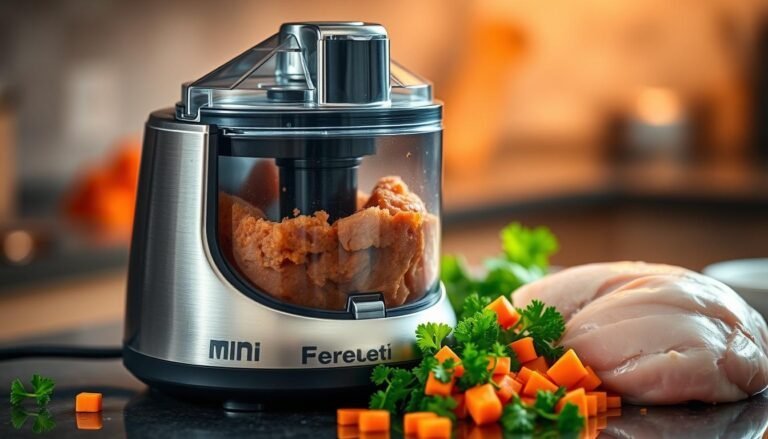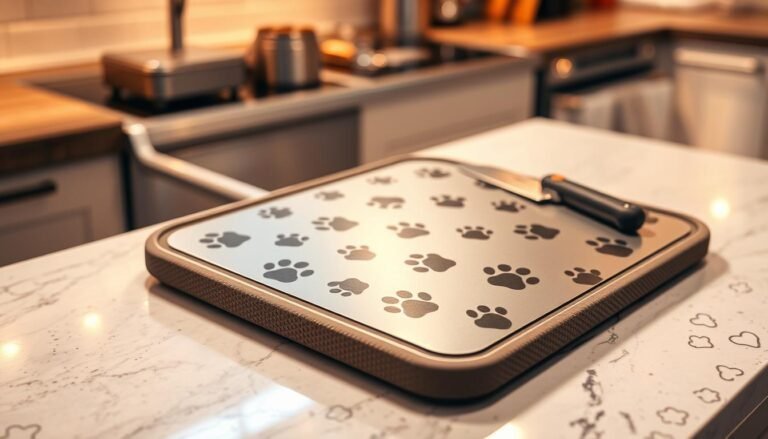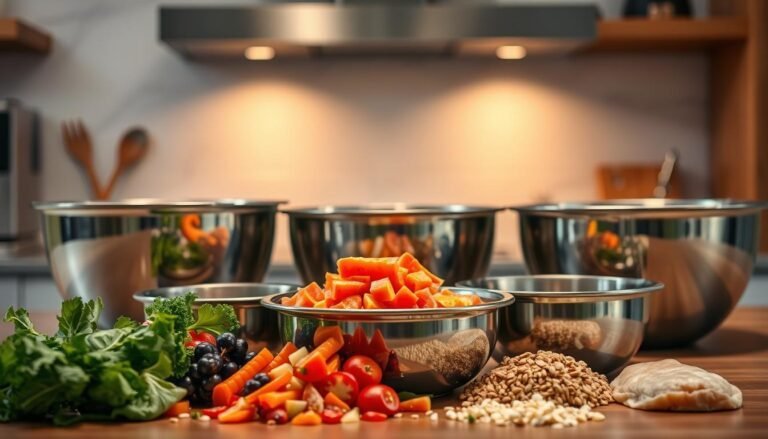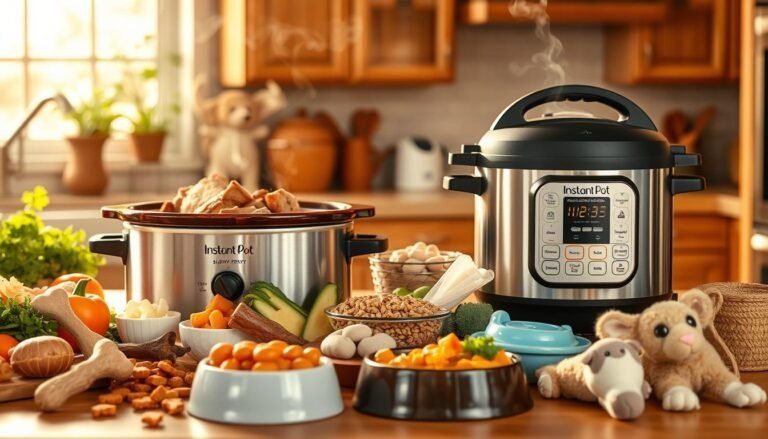Keeping pet food fresh is key to your pet’s health. As a pet owner, you know how important it is to use the right pet meal storage containers.
With over 20 years of making freezer meals, I’ve found the right freezer-safe pet food containers are crucial. They keep food quality high and make serving easier.
In this article, we’ll look at the benefits, materials, and features of good pet meal storage containers. This will help you choose the best for your pet’s meals.
Key Takeaways
- Importance of proper pet food storage
- Benefits of using freezer-safe containers
- Features to look for in pet meal storage containers
- Materials used for making pet food containers
- Tips for managing and serving pet meals effectively
The Benefits of Meal Prepping for Your Pets
Preparing meals ahead of time for your pets has many benefits. It saves time and makes sure they get the nutrients they need. A meal prep routine can greatly improve your pet’s health and happiness.
Time and Cost Savings
Meal prepping for pets saves time during the week. It also cuts down costs by buying more ingredients and reducing waste. The right pet meal prep containers keep food fresh, reducing waste even more.
Portion Control for Pet Health
Meal prepping helps control how much food pets eat. This is key for keeping them at the right weight and getting the right nutrients. Pet food storage solutions that control portions make this easier.
Ensuring Nutritional Consistency
Meal prepping ensures pets get the same good nutrition every time. It helps make sure each meal is balanced and healthy. Using airtight pet food storage containers keeps food fresh and nutritious.
In short, meal prepping for pets has many benefits. It saves time and money, helps control portions, and ensures consistent nutrition. With the right pet meal prep containers and storage, it can be easy and stress-free.
Understanding Freezer-Safe Meal Prep Containers for Storing Pet Meals
For pet owners, knowing what makes a container freezer-safe is key. Freezer-safe containers can handle freezer temperatures without breaking. They keep the food safe and the container strong.
What Makes a Container Freezer-Safe
A container is freezer-safe if it’s made from materials that don’t break in cold. Materials like BPA-free plastics, glass, and certain types of silicone are good. They stay strong and safe in the freezer.
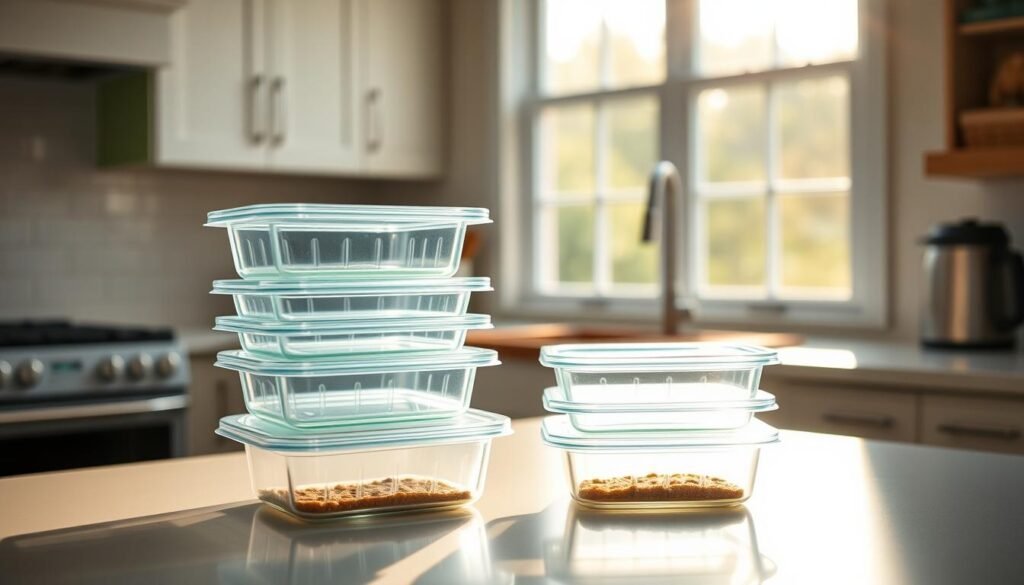
Pet Food Storage vs. Human Food Storage Differences
Some containers work for both human and pet food. But, pet food can have bacteria like Salmonella. This can spread to humans if not handled right.
So, containers for pet food should only be used for pets. They must be airtight to keep out moisture and other bad stuff.
Temperature Considerations for Pet Food
Keeping the freezer at a steady temperature is very important. The best temperature is 0°F (-18°C) or colder. Avoiding big temperature changes is also key.
Using a freezer thermometer helps make sure your freezer is safe.
Essential Materials for Freezer-Safe Pet Food Containers
Freezer-safe pet food containers are made from different materials. Each has its own good and bad points. The right material can keep your pet’s food fresh and safe.
BPA-Free Plastic Options
BPA-free plastic containers are popular. They are light and won’t break easily. But, some worry about other chemicals leaking into food.
Glass Container Benefits and Limitations
Glass containers are safe and can handle many temperatures. But, they are heavy and can break. Still, many pet owners think they are worth it.
Silicone Alternatives
Silicone containers are flexible and strong. They are good for the freezer and easy to clean. They are safer than some plastics.
Stainless Steel Durability
Stainless steel containers last a long time. They are good for those who want something that lasts. But, they might not work for all pet foods, especially acidic ones.
| Material | Durability | Safety | Flexibility |
|---|---|---|---|
| BPA-Free Plastic | Moderate | High | Low |
| Glass | High | High | Low |
| Silicone | High | High | High |
| Stainless Steel | Very High | High | Low |
When picking a freezer-safe pet food container, think about its durability, safety, and how flexible it is. This will help meet your pet’s needs.
Key Features to Look for in Pet Meal Storage Containers
Choosing the right pet meal storage container is important. It keeps pet meals fresh, safe, and easy to store. Look for features that make the container useful and effective.
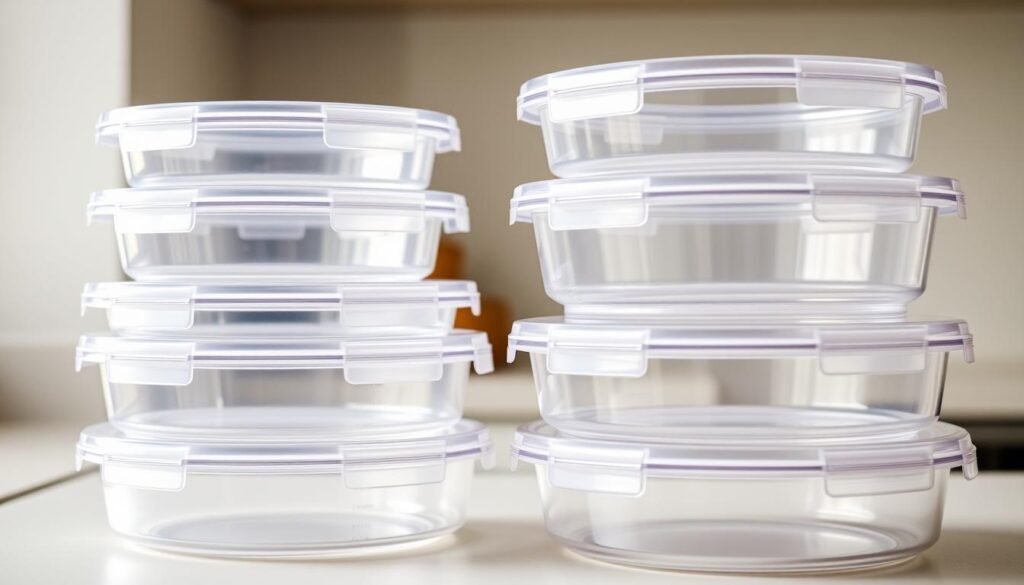
Airtight Seals and Their Importance
An airtight seal keeps pet food fresh by blocking air, moisture, and contaminants. Airtight seals keep the food’s nutritional value and taste good. Look for containers with tight lids or silicone gaskets for best results.
Stackability for Freezer Organization
Being able to stack containers is a big plus for freezer space. Stackable pet food containers help keep things tidy. This makes it easier to find and manage meals, saving space and reducing mess.
Portion Control Dividers
Portion control dividers are key for meal prep. They help separate portions, making it easy to serve the right amount. Containers with these dividers offer flexibility and help with portion control.
Durability and Longevity Factors
The container’s durability is key for daily use and freezer storage. Choose containers made from BPA-free materials that don’t crack or fade. Look at material thickness, construction, and temperature resistance for durability.
By considering these features, pet owners can find the best containers for their pet’s meals. This ensures a convenient, safe, and healthy way to store meals.
Top Freezer-Safe Container Options for Different Pet Types
Choosing the right freezer-safe containers for your pet’s meals is crucial. It keeps them healthy and happy. Each pet has its own storage needs. Knowing these helps pick the best pet food storage containers.
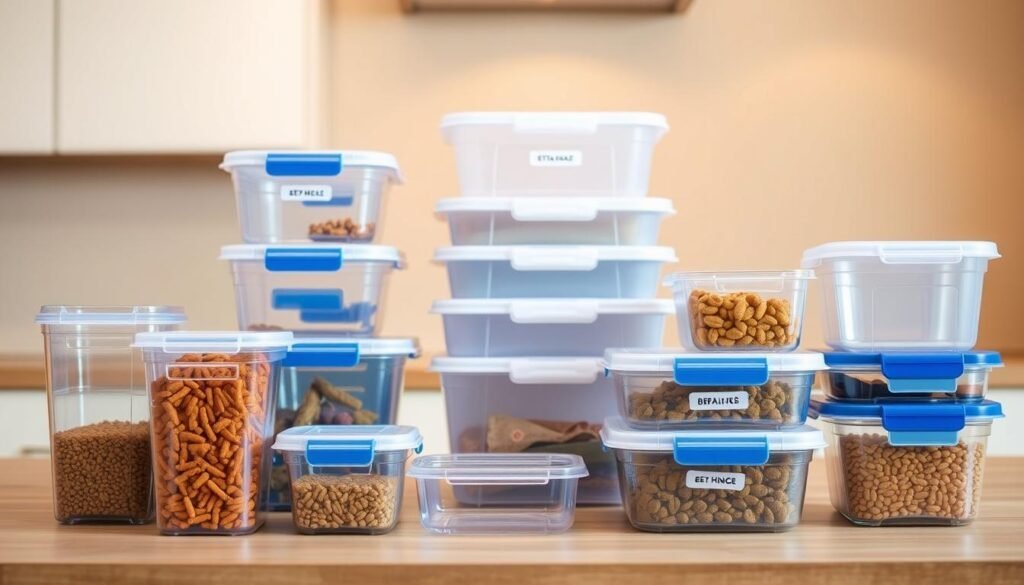
Best Containers for Dog Food Storage
The size and breed of your dog matter when picking pet meal prep containers. Whether big or small, there are special things to think about.
Large Breed Solutions
Big dogs eat more, so they need big containers. Look for pet food storage containers that are big but also keep food fresh. For more tips, see this guide on the best dog food.
Small Breed Considerations
Small dogs eat less and need smaller containers. Pet meal prep containers that are compact are perfect for their meals.
Cat Food Storage Solutions
Cats eat differently than dogs and need special storage. They eat less, so their containers should be smaller and easier to manage.
Small Pet Food Storage Considerations
Small pets like hamsters and rabbits have unique needs. They need small containers that keep their food fresh without taking up too much space.
Multi-Pet Household Organization Systems
For homes with many pets, staying organized is important. Using different pet food storage containers and pet meal prep containers helps. Labels can make things even easier.
Eco-Friendly and Sustainable Pet Food Storage Options
Pet owners are now more aware of the environment. They want to reduce waste and lower the impact of pet care on the planet. We will look at ways to store pet food in an eco-friendly way.
Biodegradable Container Materials
Biodegradable materials are a big step forward in pet food storage. They break down naturally, cutting down on plastic waste and carbon emissions. Biodegradable materials come from plants like cornstarch or sugarcane. They are a green alternative to regular plastics.
Reusable vs. Disposable Options
The choice between reusable and disposable containers matters for pet food storage. Reusable containers like stainless steel or glass last a long time. They cut down on waste. Disposable containers, on the other hand, add to plastic waste. Choosing reusable options helps the environment.
Reducing Your Pet’s Carbon Pawprint
Lowering your pet’s carbon pawprint is more than just using eco-friendly storage. It’s about the whole life of the product, from making to throwing away. Pet owners can help by picking products with little packaging, buying in bulk, and supporting green companies. These choices help make a better future for pets.
Some ways to lower your pet’s carbon pawprint include:
- Choosing products with minimal or biodegradable packaging
- Buying pet food in bulk to reduce packaging waste
- Supporting companies that use sustainable practices
- Using reusable containers for pet food storage
By using these strategies, pet owners can greatly lessen their pet’s environmental impact.
How to Properly Prepare and Freeze Pet Meals
To keep pet meals fresh and safe, follow the right steps. It’s important to prepare and freeze them correctly. This keeps the meals quality and safe for pets.
Cooling Before Freezing
Let pet meals cool to room temperature before freezing. This stops bacteria growth and keeps the meal’s texture. It’s especially important for cooked meals.
Portioning Strategies
Divide pet meals into the right portions before freezing. This makes thawing and serving easier. Use freezer-safe pet food containers or bags for storing these portions well.
| Portioning Method | Benefits | Considerations |
|---|---|---|
| Individual Serving Containers | Easy to thaw and serve, reduces waste | Requires more storage space, initial investment in containers |
| Bulk Freezing with Dividers | Saves storage space, cost-effective | May require more time to thaw, dividers needed |
Labeling Systems for Organized Storage
Label frozen pet meals with date, meal type, and feeding instructions. This keeps storage organized. It ensures older meals are used first and pets get a varied diet.
Preventing Freezer Burn
Remove air from containers or bags before sealing to prevent freezer burn. Airtight pet meal prep containers help keep meals fresh longer.
By following these tips, pet owners can give their pets nutritious, safe meals even after freezing. Proper preparation and storage are vital for pets’ health and well-being.
Storage Duration Guidelines for Frozen Pet Food
Knowing how long you can store frozen pet food is key to keeping your pet healthy and happy. The storage duration for frozen pet food varies. It depends on whether the food is raw or cooked. Understanding these guidelines is crucial for maintaining the quality and safety of the food.
Raw Pet Food Storage Timeframes
Raw pet food has a shorter storage life compared to cooked meals. It can be safely stored in the freezer for up to 6 months. It’s essential to follow proper handling and storage practices. This prevents contamination and maintains nutritional value.
Cooked Meal Storage Limits
Cooked pet meals can last longer in the freezer if stored correctly. They can be stored for 8 to 12 months. It’s crucial to cool the meals properly before freezing. Use airtight containers to prevent freezer burn and maintain freshness.
Signs Your Frozen Pet Food Has Gone Bad
It’s vital to check for signs of spoilage before serving frozen pet food. Indicators that the food has gone bad include off smells, slimy texture, or visible mold. If you notice any of these signs, it’s best to err on the side of caution and discard the food.
| Pet Food Type | Storage Duration | Signs of Spoilage |
|---|---|---|
| Raw Pet Food | Up to 6 months | Off smell, slimy texture |
| Cooked Pet Meals | 8 to 12 months | Visible mold, off smell |
By following these guidelines and being aware of the signs of spoilage, you can ensure that your pet enjoys safe and nutritious meals. Proper storage and handling practices are key to maintaining the quality of frozen pet food.
Health and Safety Considerations for Frozen Pet Food
Frozen pet food is a healthy and easy option. But, it needs careful handling to stay safe and nutritious. Keeping your pet’s meals healthy involves a few important steps.
Preventing Bacterial Contamination
Bacteria can be a big problem with pet food. To stop this, use airtight, freezer-safe containers for storing. Always use clean tools and wash your hands before and after touching the food or its containers.
Thawing Methods That Preserve Nutrients
Thawing frozen pet food right is key to keeping its nutrients. The best way is to thaw it in the fridge or with cold water. Change the water every 30 minutes. Don’t thaw at room temperature, as bacteria can grow fast. After thawing, use the food right away or keep it cold at 40°F (4°C) or below.
Avoiding Common Food Safety Mistakes
Don’t forget to label containers with dates and keep food at 0°F (-18°C). Also, use a first-in, first-out system to avoid old food. Check your freezer’s temperature often.
| Food Safety Practice | Benefit |
|---|---|
| Store in airtight containers | Prevents bacterial contamination |
| Thaw in refrigerator or cold water | Preserves nutrients and prevents bacterial growth |
| Label containers with dates | Ensures older stock is used first |
By following these tips, you can keep your pet’s frozen meals safe and full of nutrients.
Conclusion: Optimizing Your Pet’s Nutrition with Proper Meal Storage
Keeping your pet’s meals stored right is key for their health. The right containers can really help keep meals fresh.
It’s important to pick containers that are safe for the freezer. These protect meals from freezer burn and keep nutrients in. Choose containers that are BPA-free or made of glass for safety and health.
Storing meals well is more than just the right containers. You also need to know how to freeze and thaw meals safely. Following these tips can improve your pet’s nutrition and health.
Investing in good containers and following meal storage tips can keep your pet healthy. It ensures they get the nutrients they need.
FAQ
What are the best materials for freezer-safe pet food containers?
How do I prevent freezer burn when storing pet meals?
Can I store raw and cooked pet food together in the same container?
How long can I safely store frozen pet food?
What are the benefits of using stackable pet food containers?
Are biodegradable pet food containers a viable option?
How should I thaw frozen pet food to preserve nutrients?
Can I use human food storage containers for pet food?
What features should I look for in pet meal storage containers?

Ryan Conlon is the founder of PetFriendlyRecipes.com, a resource dedicated to helping pet owners create simple, healthy meals and treats at home. With a background in web publishing and a focus on practical content, Ryan built the site to make homemade pet food easier to understand and more accessible for everyone.
Subscribe to Our Newsletter


